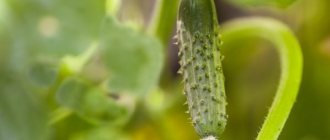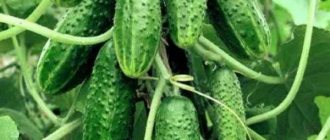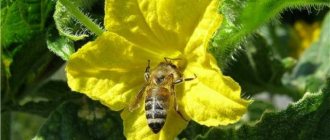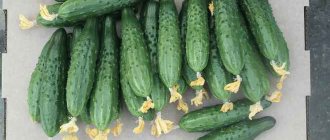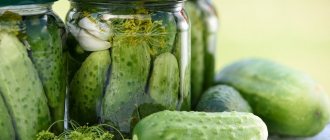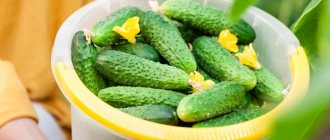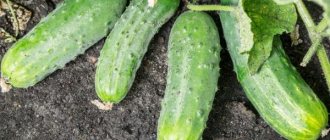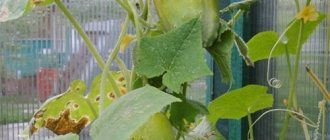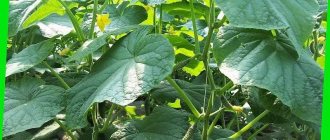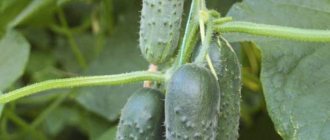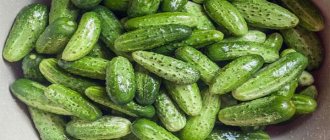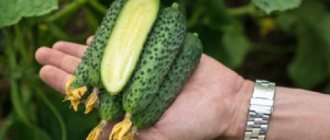Characteristics of cucumbers of the Alligator variety
Each new season in gardening begins with the selection of crops and varieties for cultivation in the garden. Cucumbers are often included in the lists of selected crops. Experienced gardeners, and even beginners, are in search of new varieties that will not only be of high quality, but will also surprise with their unusual shape or color; among these, it is worth highlighting the Alligator cucumber variety.
Characteristics of cucumbers of the Alligator variety
Characteristics of the variety
The variety is classified as fast-ripening - fruit ripening occurs in 40-45 days. It has high productivity. From 1 sq.m. you can collect about 16 kg of cucumbers. Its resistance to various unfavorable changes in conditions is also noted. Suitable for growing in conventional greenhouses and open beds.
Description of the bush
The variety is of indeterminate type, vigorous bushes with a well-developed root system. The climbing ability is good, it can easily climb along a horizontal support. The medium leaves have a pentagonal shape with smoothed corners, uniformly green in color, slightly pubescent. A plant with a female type of flowering, up to two fruits are formed in the internodes.
Description of the fruit
Alligator cucumbers are often chosen for planting because of the unique shape of the fruit. Cucumbers of this variety grow up to 45 cm in length, but have a small circumference, weighing on average 300g or more.
Appearance of fruits:
- elongated cylindrical shape;
- tuberosity is medium;
- short spines in small numbers;
- the pulp is light, homogeneous;
- the seeds are very small and elongated.
Alligator f1 cucumbers have very high taste qualities; they have a clear cucumber taste, juiciness and a slightly sweetish taste. A table variety, used in salads and even desserts.
In order for the plants to develop well, and for the fruits to be large, crispy and tasty, of the correct shape, even such an undemanding variety needs care and proper agricultural technology. When growing cucumbers, it is important not only to choose a variety, but also to plant, water, and feed correctly, so that strong bushes will delight you with a high yield.
Landing
The plant needs good lighting
This variety can be grown either by seedlings or without seedlings. If you grow cucumbers through seedlings, you can get the harvest 1-2 weeks earlier than those sown directly into the ground.
- Seeds for seedlings are sown no earlier than the 20th of April, in loose, disinfected soil. Peat pots are used, and with them it will be possible to plant seedlings in the garden without damaging the root system.
- Seeds are sown in open ground or a greenhouse when the soil temperature reaches 15 C. Cucumber seeds are deepened into the ground 2-3 cm and covered well with soil. After sowing cucumbers in open ground, they can be covered with non-woven material or film.
The Alligator f1 cucumber bed must be well prepared.
Cucumbers love loose, well-drained soil, fertilized with mineral or organic fertilizers. The landing site should be well lit and ventilated. When planting bushes, you need to maintain a distance between bushes of 40x50 cm per square meter. m there should be no more than two plants.
Cucumbers "Alligator f1": description of the variety, planting and care
Alligator f1 cucumbers are an early-ripening vegetable crop that forms a massive harvest within a month and a half after full germination. This bee-pollinated hybrid is characterized by long-term fruiting and is recommended for growing in spring film greenhouses, as well as on open ground ridges.
Characteristics of the variety
The variety is included in the State Register of the Russian Federation as suitable for cultivation in spring film unheated greenhouses in private household plots. The originator of this hybrid form is the well-known agro.
The bushes are vigorous, medium-climbing, with tufted ovaries. The length of the main stem is about 2.5 m. The length of commercial greens is from 35 cm to 40 cm, weight is 300-310 g. The surface is coarsely tuberous. The shape is elongated-cylindrical.
The pulp is tender, juicy, sweet, without bitterness. The plant is disease-resistant and is not susceptible to cucumber mosaic virus and powdery mildew. Among other things, the originator of the variety claims that the plants are highly resistant to stress. The total yield of this hybrid form varies from 14 to 16 kg/m². The taste and commercial qualities of cucumbers are high.
Landing rules
For this hybrid form of cucumbers with a high level of fruiting, areas with good quality soil composition, which are illuminated by the sun for the longest possible time, should be allocated.
It is very important to use areas for planting where there is no close groundwater, and there is also no risk of flooding as a result of heavy rainfall
The soil must be well warmed and fertilized. The most loose and light soil possible for cucumbers is suitable so that the surface root system of the plant can receive sufficient nutrition for abundant fruiting. Seed material should be sown after the threat of spring frosts has passed, when the soil warms up to 10-12 °C. The sowing pattern is 50 x 50 cm with the prepared seed material buried 3-4 cm. Before sowing, it is recommended to soak the seeds in a solution of potassium permanganate and then dry them.
Features of care
Like most other long-fruited varieties, the hybrid form "Alligator f1" needs watering with warm water at least twice a week, and also responds well to spraying the leaves with warm water. To increase the yield and extend the fruiting period, it is advisable to apply foliar fertilizing with a urea solution a couple of times per season.
In order for the greens of cucumbers of this hybrid form to turn out correct, even and beautiful, they must hang down.
Cucumbers “Alligator f1”: features of the variety (video)
These cucumbers tolerate transportation well and do not lose their marketable appearance. Many gardeners recommend the seedling method of growing, in which a plant ready for planting should not have less than 2-3 well-developed, true leaves. And by adding sawdust and ash into the holes when planting, you can significantly increase the yield.
Description of the Alligator variety
Alligator cucumbers are an early ripening hybrid. The ripening of the crop can be observed 46-49 days after emergence. The bushes are indeterminate, powerful, and grow quickly. The root system is well developed, thanks to which the bushes can withstand drought. The leaves are medium in size and have a pleasant green color. The petioles are small, with fluff. Up to 2 fruits can be formed in the internodes. Flowering is observed 3 weeks after emergence. The buds are large and yellow.
Flowering is observed 3 weeks after emergence
Cucumbers have an elongated, cylindrical shape and can be significantly narrowed in the area of the stalk. The length of the greens is 35-40 cm, weight – 280-310 g. The color is dark green, rich. The skin has visible, rather large tubercles on which spines are located. The peel is shiny, thin, not bitter and easy to eat. The flesh is dense and crispy. The seeds are small, long, and practically unnoticeable when eaten.
Main characteristics
This is a fast-ripening variety of cucumbers; fruit ripening occurs 45 days after germination. The plants themselves are very powerful, strong, and tall. Branching is moderate, flowering is mainly of the female type. From 1 to 3 fruits are formed in the leaf axil. The leaves are dark green in color and are of moderate size. The root system is very well developed, due to which the crop can easily survive even severe drought. The petioles are small and pubescent. Flowering occurs 3 weeks after emergence. Large yellow buds grow. Summer residents like this variety because there are usually no problems with growing plants.
Characteristics of cucumbers Alligator F1
In gardening, the Alligator F1 cucumber is in great demand. To understand why this hybrid is so attractive, it is necessary to study its characteristics.
- The hybrid requires pollination by bees, so it is rarely chosen for greenhouse cultivation.
- There is a stable immunity to true and downy mildew, cucumber mosaic.
- The bushes are not afraid of short-term and return frosts and drought.
- Productivity per square of plantings is 14-16 kg.
Productivity per square of plantings 14-16 kg
Technical description of the cucumber variety Alligator F1
Under the name Alligator, two different varieties of cucumbers from Sedek are listed in the State Register of the Russian Federation, but their technical characteristics are very similar. So, the f1 hybrid is suitable for growing in film greenhouses in the Northern, North Caucasus, Volga-Vyatka, Middle Volga, Northwestern and Central Black Earth regions.
The bushes of the Alligator cucumber variety are powerful with an average degree of branching. Flowering type: female. Each leaf axil produces 1–3 fruits. The medium-sized leaves are dark green in color.
The author’s description of cucumbers of the Alligator f1 variety says that they have a medium-tubercular surface with short light stripes. The shape of the fruit is elongated-cylindrical, the length reaches 40 cm, and the weight is 320 g. The pubescence is light and of medium density. The total yield of the hybrid form is equal to 14 – 16 kg/sq.m.
The juicy, sweetish pulp increases consumer demand for vegetables, but it is better to consume them fresh. Pickling is made difficult by the large size of the cucumbers. They can only be preserved in the form of slices.
Sowing Alligator cucumbers with seeds
You can choose a sunny or partially shaded place to grow the crop. The groundwater level should be low, and the soil should be fertilized and loose. As a fertilizer, you can take minerals (superphosphate, urea) or organic matter, such as humus, compost, wood ash.
The groundwater level should be low, and the soil should be fertilized and loose
Sowing seeds in open ground or a greenhouse is usually carried out in May or June. In the evening, the seeds should be soaked in a weak solution of potassium permanganate. The beds for sowing seeds are dug up, fertilized and watered. The holes are made at a distance of 50 cm and with a row spacing of 50-70 cm. The depth of seeding is 3-4 cm. Seeds germinate in open ground or a greenhouse at a temperature of +20...+25 degrees.
How to plant cucumber seedlings correctly
You can also grow Alligator cucumbers using the seedling method to get an earlier harvest. Sowing seeds for seedlings is done in April-May. The seeds are sown in separate pots, because young shoots cannot tolerate picking. As they grow, seedlings need to be watered on time and provided with sufficient lighting. Feeding can be done, but is not necessary. This is usually done to prevent the seedlings from overgrowing or if there are clear signs of mineral deficiency.
Transplantation of seedlings into open ground occurs in May-June
Transplanting seedlings into open ground occurs in May-June, when warm weather sets in. In order for the seedlings to grow faster, it is best to start hardening 1-2 weeks in advance. By the time of transplanting into the ground, the sprouts should already have 2-3 true leaves. The distance between seedlings is maintained at 50-70 cm so that the cucumbers have room to grow and develop.
Alligator cucumbers
Alligator cucumbers
Small short cucumbers in the so-called Russian shirt with stripes have always been loved by summer residents. Isn't it time for us to try something new? Breeders have developed amazing hybrids of long greens - salad and appetizing. And the Russian mouth is always happy with a big piece!
We are talking about “crocodile” cucumbers: Emerald Flow Fı, Alligator Fı, Crispy Alligator Fı. There is also a whole series under the general title “Chinese Sustainable Fı”.
What are they good for?
- Unusual. The length of the fruit reaches 40 cm, but many gardeners, impatient, usually remove 25–30 cm of greens from the bush. The fruits with large pimples seem to be dressed in real alligator crocodiles skin. Just their appearance in the garden surprises those who are accustomed to standard domestic greens.
- Very sweet. The cut flesh is dense, without voids and very juicy. As soon as you cut a cucumber, juice will immediately flow out of it. “Alligators” grow sweet under any conditions, they are like that by definition, this is their main property. The same cannot be said about gherkins, which can taste inexplicably and unexpectedly bitter.
- Fragrant. Many vegetables have a “passive smell”: until you bring it close to your nose, you won’t feel it. Alligator cucumbers have an “active aroma” - fresh, bright, instantly spreading throughout the house when preparing a salad or fresh hash. Many vegetable growers compare it with watermelon in intensity and appetizing.
- Good as lightly salted ones. “Alligators” are not suitable for long-term harvesting, but they are very suitable for salted salt. Cut the cucumbers into small barrels, pickle them, and in just a few days you will have a wonderful snack ready. The brine is evenly distributed in the pulp through large tubercles, the “barrels” are perfectly salted and crunchy.
- Generous with the harvest. When the “alligators” are at the peak of fruiting, 6–8 elongated and the same number of small fruits ripen simultaneously on one plant. From one plant you can harvest up to 20 kg per season!
If you grow several other varieties of salad cucumbers in a separate greenhouse in the same quantity as “alligators,” you will get the impression that the latter are planted 2–3 times more than other varieties. Moreover, when these others stop bearing fruit, the “alligators” continue to produce crops.
- Compact. Each plant does not extend far in different directions and does not occupy much space, because cucumbers are located mainly on the main stem. The harvest is immediately visible.
- Early ripening. "Alligators" are ready for harvesting after 25–30 days from germination. They can be planted several times per season. The first time was in March, so that already on the May holidays, several long fruits per plant could be picked in the greenhouse. Well, the last sowing can be done in August, which will allow you to have your own super-sweet harvest of fresh vegetables for as long as possible.
- Curvy. The fruits do not get fat or turn yellow, which is very convenient for summer residents who rarely come to their plot. If the gherkin, when it outgrows, changes color and shape, and loses its taste, then the “alligator” retains its impressive appearance on the vine for a long time and only grows in length.
- Unpretentious. The plasticity of “crocodile” cucumbers is amazing: no matter where you live, no matter where you sow the seeds, the plants will get used to any climate. On hot days, the Chinese heat-resistant Fı is most productive, when it gets colder, the Chinese cold-resistant Fı bears fruit better, at the end of summer there is a greater return from the Chinese disease-resistant Fı. And Chinese Farm Fı, Alligator Fı, Emerald Stream Fı feel great everywhere and always.
Are they difficult to grow?
Agricultural technology for “alligators” is the same as for ordinary cucumbers familiar to summer residents. And even easier! These vigorous hybrids can bear fruit both in protected and open ground, although it is clear that they show the best results in greenhouses and greenhouses.
Since the main crop ripens on the main stem, the side shoots are pinched after the second or third harvest. The “alligator’s” lash must have support and grow “in height.” If you do without support and without a garter, long cucumbers on the ground sometimes lose their shape.
“Alligators” are resistant to unfavorable conditions and low light, so they can be grown even in winter on a window or in a heated greenhouse. At this time, the plant is watered moderately (the soil should be slightly dry) until fruit sets. Then there will be more harvest. As soon as the first fruit begins to swell, water the vine generously, preferably at night.
Baby cucumbers
Svetlana Vorontsova, Vologda: “I never understood why it’s impossible to consider any small cucumbers just formed on a whip as pickles or gherkins?”
If a variety or hybrid assumes a fruit length of 13–15 cm, its 1–2-day ovary may still be immature. It does not look like a cucumber, but sometimes looks like an extension of the stem. In addition, it is completely tasteless and flavorless.
A completely different matter - special baby cucumbers - pickles and gherkins! They just started and the very next day they have the shape of a cucumber with pimples. And crispy, and tasty, and smell like ripe ones.
There are many such Fı hybrids today. For example, Son of the Regiment, Filippok, Moth, Baby Son, Sugar Baby, Spring.
They can be picked at different stages of growth and not only eaten fresh, but also used in different types of preparations.
In a 200 ml mayonnaise jar it is easy to preserve 1-2-day-old ovaries - pickles. More than a hundred of them will fit there! Well, the larger ones - mini gherkins, 4-6 cm long - are suitable for a 250 ml jar with a steeper marinade. Gherkins (they stretch up to 7–8 cm) are salted or pickled in a half-liter container.
The pulp of these cucumbers becomes even crispier after cooking. At the table they are eaten without a trace, like seeds that are difficult to tear yourself away from.
Agricultural technology is also quite common for them. The only detail: they need to be collected not just daily, but sometimes several times a day! And it's better in the morning. They must be placed in the refrigerator immediately so that they are better preserved and crispier when marinated and salted.
Based on materials from the publication “Gardener’s World” No. 21,
photo - WIKIPEDIA
Caring for Alligator cucumbers
The hybrid is unpretentious and can be grown even in unfavorable conditions.
- The Alligator cucumber can be grown on a trellis or simply let it trail along the ground. But in the case of trellis growing, supports are made immediately after planting the seedlings, because the crop develops quickly.
- Watering is carried out once every 2-3 days, and during drought, in the summer, you can add water to the roots every day. This procedure is carried out in the early morning or evening, when the sun is setting. The water should be warm, preferably settled.
- Weeding is done after each watering or rain so that the soil does not form a dense crust. While weeding, it is also necessary to remove all weeds to keep the area clean.
In the case of trellis growing, supports are made immediately after planting the seedlings
- Fertilizers are applied 3 times per season. The first feeding is done 2-3 weeks after emergence or planting of seedlings. At this time, a urea solution (15-20 g/1 l of water) is added so that the plants can grow green mass. When the first buds appear, spray with superphosphate (25-30 g/bucket of water). The third feeding is done when the first cucumbers appear. At this time, you can add the NPK complex.
- Yield rationing is usually not required. Alligator cucumbers produce a harvest commensurate with their strength, so there is no point in picking very small fruits or ovaries so that most of the crop can fully ripen.
Planting and care
Cucumber vine prefers high-quality soils with sufficient sunlight. When choosing a plantation for planting cucumbers of the Alligator f1 variety, it is important to find a site that will not be at risk of being flooded by heavy rainfall or groundwater. Deep waters should not be close to the earth's surface.
The soil at the time of sowing the seeds should be well warmed and fertilized. The root system of plants quickly receives nutrients from breathable, light soil, so the beds have to be loosened frequently.
Planting material is placed in the ground in stable warm weather, when spring frosts are behind us and the soil has warmed up to at least +10°C. The recommended sowing pattern for cucumbers is 50 x 50 cm with seeds buried at 3–4 cm. The material for sowing is prepared by soaking in a manganese solution and drying.
Caring for the long-fruited hybrid Alligator consists of watering with warm water. The plantation is moistened twice a week and the leaves of the bushes are periodically irrigated with clean water. To increase yield and prolong fruiting, foliar feeding of bushes is done 2 times per season using a urea solution.
It is recommended to grow cucumbers on strong trellises, since pegs and ropes may not support the heavy weight of highly developed plants. Supporting structures must be as reliable as possible. In order for the cucumbers to have the correct elongated shape, they must hang from the trellis.
Diseases and pests on cucumbers
Pests and diseases appear on Alligator bushes usually due to improper care. To strengthen the immunity of cucumbers and destroy some diseases (if any have already appeared), you can use a fungicide such as Trichodermin. A good alternative may be the drugs Strobi, Alyette, Previkur, Infinito, Hom and the like.
Diseases and pests of Alligator cucumbers
Cucumber Alligator F1 suffers more from pests than diseases. Nematodes, spider mites, and aphids are the most common guests of bushes. If a small number of pests appear, you can use soapy water for treatment. But if pests quickly spread throughout the area, it is worth using Bordeaux mixture. Among the strong insecticides that can destroy intrusive pests in a short time, you can choose Aktara, Inta-Vir, Actellik, Antiklesch, Metaldehyde.
Diseases and pests
The hybrid has strong immunity to rot and powdery mildew.
Among the pests at risk, aphids and honeybees are at risk. Folk remedies and insecticides are used to protect bushes. How to choose cucumbers for planting on your own plot with today's abundance of offers? This question sooner or later faces gardeners. The main criterion is purpose. One of the universal cucumbers is Crocodile Gena F1 from the Aelita company. You can get acquainted with a detailed description of the hybrid, its advantages in comparison with other varieties, the secrets of obtaining a high yield and reviews from amateurs in the article.
Harvesting and processing of cucumbers
Harvesting occurs in July-August. During this time, most of the greens are collected. In the fall, only a few of the most resistant bushes remain, which continue to produce a little fruit. Cucumbers are collected as they ripen. It is not worth keeping greens on the plant, because over time they become tougher and lose their taste.
The Alligator cucumber is most often used just for fresh eating.
The Alligator cucumber is most often used simply for fresh eating. They are good in appetizers and salads. They can also be taken for preservation and pickling, but for convenience they are crushed or cut into large slices.
Reviews from gardeners about cucumbers of the Alligator F1 variety
The opinions of gardeners about Alligator F1 cucumbers are presented below.
- Marina Topoleva : “The Alligator F1 cucumber is indispensable for salads and summer snacks of any kind. They are most delicious when fresh, but I didn’t like them in jars. Their aroma is very pleasant, the flesh is incredibly juicy and sweetish. I grow them every year, but the harvest is not always large, perhaps due to a lack of minerals in the soil. Can grow in shaded areas, very hardy. I am completely satisfied with this hybrid – it justifies the planting.”
- Andrey Luchinov : “Among all the cucumber hybrids that I tried to grow on the plot, only Alligator F1 captivated me. In comparison with other species, it has many of the qualities that I value above all, namely: productivity, aroma, sweetish taste. These cucumbers are never bitter, crisp, dark green in color, so they are clearly visible on the bushes among the foliage. I recommend it to both experienced gardeners and beginners - they are easy to grow.”
- Diana Voinik : “Previously, we planted cucumbers only in greenhouses, but now we use exclusively open ground for this, and therefore the varieties have changed. One of my favorites is Alligator. It is not troublesome to care for, produces a decent harvest, and has decent taste. True, it also has a drawback - the fruits are prickly. After ripening, they are covered with small but visible thorns, which my husband simply wipes with his hands, but my daughter and I have to use a cloth for these purposes. This makes collecting greens a real hassle, but they are worth the effort!”
Description and characteristics of the variety
Cucumber Crispy Alligator F1 is a hybrid that requires the presence of pollinators in fruit formation. It is cultivated outdoors and in protected beds. Ripening begins in the mid-early period.
What are the differences between a hybrid:
- vigorous bushes with moderate branching;
- mixed flowering;
- pollination by bees;
- 1 ovary is formed in 1 sinus.
Long cucumbers have a beautiful appearance and wonderful taste; they are used fresh in cooking; they can be prepared after cutting into pieces.
- length 30-35 cm;
- weight 280-300 g;
- tubercles are frequent and large;
- neck elongated;
- diameter up to 4 cm;
- flattened, cylindrical shape;
- the pulp is juicy, not watery;
- The consistency is strong.
